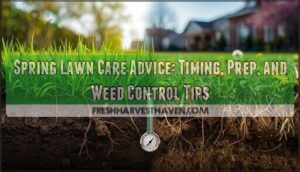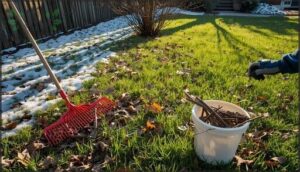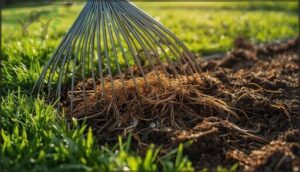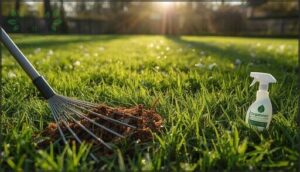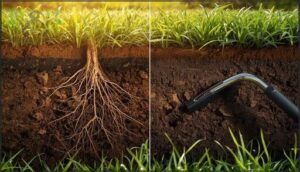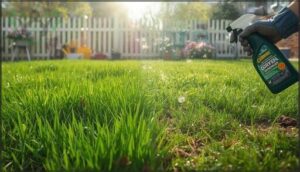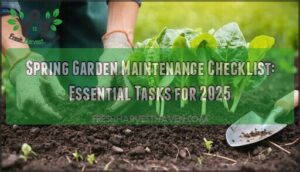This site is supported by our readers. We may earn a commission, at no cost to you, if you purchase through links.
Your neighbor’s lawn is already thick and green, but yours still looks patchy and tired. The difference isn’t luck—it’s timing. Spring lawn care works best when you sync your efforts with soil temperature, not the calendar date, because grass roots respond to warmth in the ground, not the air above.
If you fertilize too early, you’ll feed weeds instead of grass. Wait too long, and you’ll miss the narrow window when pre-emergent herbicides actually work. Getting these details right transforms a mediocre lawn into one that stays dense and weed-resistant all season, and it starts with understanding what your soil and grass are telling you right now.
Table Of Contents
- Key Takeaways
- When to Start Spring Lawn Care
- Clearing and Preparing Your Lawn
- Improving Soil Health and Aeration
- Fertilizing, Seeding, and Watering Strategies
- Weed and Pest Control for Spring Lawns
- Frequently Asked Questions (FAQs)
- What is spring lawn care & maintenance?
- How do you care for a lawn in spring?
- What is a good spring lawn care routine?
- Should you start your spring lawn care routine right?
- Can You top-dress a lawn in spring?
- How do I care for my lawn in the fall?
- When should I start spring lawn care?
- How do I repair winter salt damage?
- What causes brown patches after winter?
- Should I use organic or synthetic fertilizers?
- Conclusion
Key Takeaways
- Start spring lawn care when soil temperature reaches 50-55°F rather than following calendar dates, since grass roots respond to ground warmth and timing fertilizer or pre-emergent herbicides incorrectly feeds weeds instead of grass.
- Core aeration relieves soil compaction more effectively than spike methods by removing soil plugs, allowing water and oxygen to reach roots where compacted soil would otherwise choke growth and create standing water.
- Apply pre-emergent herbicides when soil hits 50-55°F to achieve over 90% crabgrass control, and use split applications every 6-8 weeks to extend protection throughout the season.
- Overseed bare spots when soil reaches 50-65°F using 2-3 shallow waterings daily for new seed, then switch to deep watering once or twice weekly for established turf to promote strong root development.
When to Start Spring Lawn Care
Timing is everything for spring lawn care, and starting too early or too late can set you back for the entire season. The right moment depends on your local climate, what your grass is telling you, and whether your equipment is ready to go.
Here’s how to nail the timing and get your lawn off to a strong start.
Recognizing The Right Timing by Region
Your spring lawn care timing isn’t one-size-fits-all—it depends on regional soil temperatures and climate zone calendars. Cool-season lawns in northern areas begin when soil hits 50–55°F, generally late March to May. Boundary zones start mid-February to April, while warm-season southern grasses green up earliest when temperatures reach 60°F. A key aspect involves climate specific lawn considerations.
- Cool-season northern regions: Start spring lawn care when soil temperature reaches 50–55°F (late March–May)
- Mid-Atlantic boundary zones: Begin treatments when soil warms to 45–55°F (February–April)
- Warm-season southern lawns: Initiate care as temperatures climb above 60°F (late February–March)
- Growing degree days (GDD): Use GDD tracking tools by zip code for precise timing
- Microclimate variations: Sunnier, well-drained sites show green-up indicators 2–4 weeks earlier
Watching for Early Spring Growth Signs
Once you know your regional timing window, watch your lawn for tangible growth signals. Cool-season grasses show scattered light green patches when soil temperature monitoring confirms 45–50°F readings—often the first visual indicators of dormancy break. Perennial ryegrass greens up earliest, while tall fescue lags behind.
When blades reach 3–4 inches, you’ve hit mowing readiness and can confidently launch your early season lawn care routine. Peak growth occurs when soil temperatures are ideal.
Preparing Tools and Equipment for The Season
Before that first cut, your lawn equipment deserves attention. Small gasoline engines need oil changes every 25–50 hours—check yours now. Drain stale winter fuel to prevent carburetor clogs.
Sharpen your mower blade after 20–25 hours of use; dull edges tear grass and invite disease. Calibrate your spreader so fertilizer hits target rates without striping.
Clearing and Preparing Your Lawn
Once the ground thaws and your grass starts to green up, you’ll want to clear away everything winter left behind. This step sets the stage for healthy growth by removing obstacles that block air, water, and sunlight from reaching your turf.
Let’s walk through the key tasks that prepare your lawn for the season ahead.
Removing Winter Debris and Obstacles
Before you fire up the mower, walk your yard to clear branches, stones, and toys—hidden objects can become dangerous projectiles that cause serious injuries. Start debris removal when soil temperatures consistently reach 40–45°F, usually late March through mid-April in northern zones.
- Remove leaves, twigs, and storm debris promptly to prevent disease
- Clear obstacles to protect mower blades and avoid costly repairs
- Eliminate dense leaf layers that trap moisture and encourage snow mold
- Schedule yard cleanup within 2–4 weeks after thaw for best results
- Inspect weekly for new debris that could suffocate emerging grass
Raking Thatch for Air and Drainage
Beyond clearing leaves, you’ll need to tackle thatch—the spongy layer of dead stems and roots between grass blades and soil. When thatch exceeds about half an inch, it blocks air and water from reaching roots.
Use a flexible leaf rake in spring to pull up matted areas, focusing on spots where growth looks weak. For thicker buildup above one inch, consider power raking or core aeration to restore drainage and oxygen flow.
Preventing Mold and Lawn Diseases
After winter’s long chill, mold and disease prevention set the stage for spring recovery. Thatch management and improving air circulation reduce the moist, stagnant conditions where fungal infections thrive.
- Keep soil moisture balanced—avoid waterlogged turf
- Rake matted patches to boost air movement
- Monitor high-risk areas after extended snow cover
- Apply fungicide only if disease is severe
- Focus on natural lawn disease prevention through proper lawn care practices
Improving Soil Health and Aeration
Healthy soil is the foundation of a thriving lawn, and spring is the perfect time to assess what’s happening beneath the surface. Compacted soil can choke out roots and prevent water from reaching where it’s needed most.
Let’s look at how to evaluate your soil and decide if aeration is the right move for your yard.
Assessing Soil Conditions and Compaction
You can’t fix what you don’t understand, so start by checking your soil health. Look for compaction indicators like standing water or shallow roots—these signal that your soil conditions need attention.
Soil testing reveals pH and nutrient levels, while poor water infiltration points to compaction. Compacted soil restricts root effects and microbial effects, weakening your lawn’s foundation and resilience.
Choosing The Best Aeration Method
Core aeration removes soil plugs and relieves compaction far more effectively than spike methods, especially on clay-heavy lawns. Deep-tine benefits include breaking up deeper compacted layers that standard tools miss. Liquid aeration may improve water spread but won’t reduce bulk density like mechanical aeration.
- Core aeration: Best for compacted, high-traffic lawns
- Spike aeration: Suitable for sandy soils with mild compaction
- Deep-tine equipment: Penetrates 8 inches, preventing subsurface pans
- Liquid products: Supplement only, not standalone compaction solutions
Cost considerations matter—core costs more but lasts longer.
Fertilizing, Seeding, and Watering Strategies
Once your soil is healthy and aerated, it’s time to feed your lawn and fill in any weak spots. The right fertilizer, proper watering, and strategic seeding can make the difference between patchy grass and a thick, green carpet. Here’s how to get each step right this spring.
Selecting The Right Spring Fertilizer
Choosing the right lawn fertilizer starts with soil testing to reveal what your grass actually needs. Most cool-season lawns thrive with nitrogen-dominant spring formulations like 4-1-2, while warm-season grasses may require higher nitrogen sources later.
Consider environmental impact by selecting slow-release products that minimize leaching. Match your fertilizer to your grass species and local climate factors for healthier, more sustainable fertilization results.
Proper Timing and Application of Fertilizer
Timing your fertilizer application makes all the difference—soil temperatures between 55°F and 65°F signal when cool-season grass actively absorbs nutrients.
Apply slow-release nitrogen when your lawn has fully greened and you’ve mowed once, which reduces environmental impact and prevents runoff.
Limit individual application rates to 0.5 to 1.0 pounds of nitrogen per 1,000 square feet, ensuring proper lawn condition without excessive surge growth.
Overseeding Bare or Thin Areas
Once you’ve nourished your lawn, overseed bare spots to thicken turf and choke out weeds. Prepare sites by aerating and removing debris—proper seed-to-soil contact boosts grass seed germination up to 85 percent when soil temperatures hit 50–65°F.
Overseed bare spots in spring when soil reaches 50–65°F to thicken turf and crowd out weeds naturally
Apply seed at half your establishment rate for thin areas:
- Cool-season mixes: 2.5–5 pounds per 1,000 square feet
- Dense coverage blocks 65 percent of weed seeds
- Aftercare practices like consistent watering improve establishment by 75 percent
Effective Watering Practices for Spring
After overseeding, water your grass correctly to lock in germination. New seed needs shallow, frequent watering—2–3 times daily for 5–10 minutes—while established turf thrives on deep watering once or twice weekly. Stick to early morning for best timing, cutting evaporation by 15 percent.
Smart irrigation systems adjust your watering schedule automatically, saving 15–40 percent of water while maintaining lush growth.
Weed and Pest Control for Spring Lawns
Weeds and pests can quickly undermine all the hard work you’ve put into your spring lawn care routine. The key is to prevent problems before they start and address the ones that do appear with targeted treatments.
Here’s how to protect your lawn from common invaders this season.
Applying Pre-Emergent Herbicides for Crabgrass
Before crabgrass seeds germinate, you need to apply pre-emergent herbicides when soil temperatures consistently hit 50–55°F—often late March through early April.
Products like prodiamine, pendimethalin, or dithiopyr can deliver over 90% crabgrass control when timed correctly and watered in with about 0.1–0.2 inches of irrigation.
Split applications every 6–8 weeks extend protection throughout the season.
Spot Treating Broadleaf Weeds
Once dandelions, clover, and plantain break through, you’ll need postemergent herbicides containing 2,4-D, mecoprop, and dicamba—the classic “three-way” mix that targets broadleaf weeds without harming your grass.
Spot-spray individual plants when air temperatures sit between 60 and 85°F for best absorption.
Wait until newly seeded areas have been mowed four times before treatment, and hand-pull scattered weeds to minimize chemical use.
Eco-Friendly Pest and Weed Control Methods
For those seeking organic lawn care without synthetic chemicals, several low-toxicity options deliver measurable weed control. Corn gluten meal, applied at 20 pounds per 1,000 square feet, functions as preemergent weed control and supplies nitrogen.
Iron chelate formulations spot-treat broadleaf weeds with minimal environmental impact. High-strength acetic acid herbicides burn young seedlings on contact, while entomopathogenic nematodes target soil grubs biologically, reducing pest pressure naturally.
Integrated Pest Management Strategies
Beyond organic solutions, integrated pest management balances several tactics to keep your lawn healthy with fewer chemicals. Weekly pest monitoring helps you spot problems early, cutting pesticide use by 30% to 70%. Cultural controls like proper mowing and deep watering reduce weed pressure considerably.
| IPM Tactic | Key Benefit |
|---|---|
| Resistant Varieties | Lower disease incidence |
| Biological Controls | Nematodes suppress grubs naturally |
| Targeted Pesticides | Spot-treat only when thresholds are met |
This approach combines preemergent herbicides, postemergent herbicides, and pest control methods strategically. You’ll apply treatments only when monitoring confirms the need, protecting your lawn while minimizing herbicide application.
Frequently Asked Questions (FAQs)
What is spring lawn care & maintenance?
Spring lawn care involves strategic tasks—cleanup, fertilization, aeration, seeding, and weed control—performed as temperatures warm.
These post-winter actions prepare your turf for vigorous seasonal growth, ensuring a thick, healthy lawn throughout the year.
How do you care for a lawn in spring?
You care for your lawn in spring by removing debris, testing soil, aerating compacted areas, applying fertilizer and pre-emergent weed control at proper temperatures, overseeding thin spots, and establishing consistent watering routines.
What is a good spring lawn care routine?
Like tending a garden that rewards patience, a good spring lawn care routine balances timing with action: test soil, rake debris, apply pre-emergent herbicide near 55°F, fertilize lightly, aerate compacted areas, and water consistently—prioritizing sustainable, budget-friendly practices for long-term lawn health.
Should you start your spring lawn care routine right?
Not quite yet. Wait until soil temperatures hit 50–55°F and your grass shows active growth.
Working frozen or soggy ground causes compaction, setting back your spring lawn care efforts before they even begin.
Can You top-dress a lawn in spring?
Yes, you can top-dress your lawn in spring when grass is actively growing, usually March through early May.
Light compost or sand applications improve soil structure, level surfaces, and support root development during this best growth window.
How do I care for my lawn in the fall?
Fall fertilization, best overseeding, and aeration timing are critical for winter preparation.
Focus on thatch management, weed control, and soil health from September through October.
Mow properly and water deeply to help strong grass health heading into dormancy.
When should I start spring lawn care?
Think of spring lawn care like catching a wave—too early and you’ll struggle, too late and you’ll miss it.
Start when your soil temperature consistently hits 50-55°F, usually matching your region’s frost dates and early growth indicators.
How do I repair winter salt damage?
Winter salt damage shows up as brown patches near walkways. To restore lawn health and promote recovery, flush soil with deep watering, apply gypsum to displace sodium, rake dead grass, and overseed bare spots.
What causes brown patches after winter?
Brown patches after winter often stem from fungal diseases, winter damage, or soil moisture problems. Dead grass, mold, and lawn diseases thrive when conditions favor them, while maintenance impact and pet urine damage also contribute.
Should I use organic or synthetic fertilizers?
Your choice depends on priorities. Synthetic fertilizers deliver fast results but risk water pollution and require frequent applications.
Organic options build soil health with slower nutrient release, supporting lawn performance through improved microbiology and reduced environmental impact.
Conclusion
Think of your lawn as an athlete preparing for a marathon—it needs the right fuel at the right time, not random bursts of effort. Spring lawn care advice isn’t about doing more; it’s about doing the right things when your grass can actually use them.
Sync your fertilizer with soil warmth, stop weeds before they sprout, and give roots room to breathe. Execute these steps correctly, and your lawn won’t just survive spring—it’ll dominate summer.
- https://www.unlimitedlawncare.com/about/our-blog/how-often-you-fertilize-your-lawn-in-spring
- https://www.grasshoppergardens.com/resources/blog/how-often-to-fertilize-lawn/
- https://soiltesting.cahnr.uconn.edu/suggested-fertilizer-practices-for-lawns/
- https://www.fairfaxcounty.gov/soil-water-conservation/hold-the-fertilizer-in-spring
- https://www.getsunday.com/shed/lawn/best-time-to-apply-lawn-fertilizer

